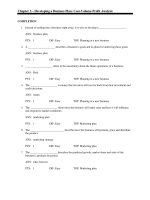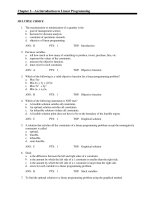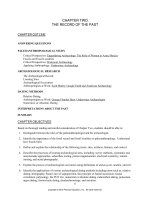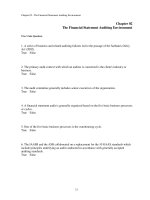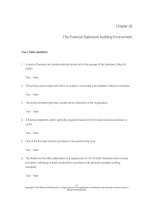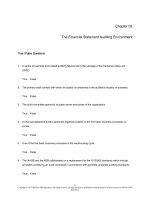Environmental science a global concern 13th edition cunningham test bank
Bạn đang xem bản rút gọn của tài liệu. Xem và tải ngay bản đầy đủ của tài liệu tại đây (31.04 KB, 9 trang )
Chapter 02 - Principles of Science and Systems
Chapter 02
Principles of Science and Systems
Multiple Choice Questions
1. _________________ is a process for producing knowledge methodically and logically.
A. Universalism
B. Science
C. Relativism
D. Morality
E. Parsimony
Bloom's: 1. Remember
Section: 02.01
Topic: Science
2. Ideally, science
A. Always has the right answers
B. Tells us what we expected to find
C. Uses new technology
D. Is orderly and methodical
E. Proves that our hypotheses are correct
Bloom's: 1. Remember
Section: 02.01
Topic: Science
3. Which of the following is not an important feature of science?
A. Reproducibility
B. Parsimony
C. Empiricism
D. Positive proof
Bloom's: 2. Understand
Section: 02.01
Topic: Science
2-1
Copyright © 2015 McGraw-Hill Education. All rights reserved. No reproduction or distribution without the prior written consent of
McGraw-Hill Education.
Chapter 02 - Principles of Science and Systems
4. Generally, distinguished scientists
A. Always agree if they really are expert scientists
B. May have different interpretations of the same evidence
C. Never disagree once a theory is established
D. Believe each other and support each other in their work
E. Always disagree so they can prove theories
Bloom's: 2. Understand
Section: 02.01
Topic: Science
5. Proof in science is always
A. Firmly established
B. Beyond question
C. An impossible goal
D. constantly changing with little contiunity between diciplines.
E. Open to question or new evidence
Bloom's: 2. Understand
Section: 02.01
Topic: Science
6. The statement, "Since every insect I have examined so far has six legs, I conclude that all
insects must have six legs" is an example of
A. Inductive reasoning
B. Deductive reasoning
C. Hypothesis testing
D. Reductive reasoning
E. Parsimony
Bloom's: 2. Understand
Section: 02.01
Topic: Science
2-2
Copyright © 2015 McGraw-Hill Education. All rights reserved. No reproduction or distribution without the prior written consent of
McGraw-Hill Education.
Chapter 02 - Principles of Science and Systems
7. From the following statements and questions, which is the best example of deductive
reasoning?
A. If all insects have six legs, then butterflies have six legs
B. In repeated tosses of a coin, there is a 50/50 chance of each toss resulting in a "head"
C. How many times will the toss of coins turn "heads-up" if 100 times toss a coin?
D. Since every insect I have examined so far has six legs, I conclude that all insects must
have six legs
E. All of these are examples of deductive reasoning
Bloom's: 2. Understand
Section: 02.01
8. Although your sister is not a scientist, she says that she uses scientific techniques in her
everyday life. You do not believe her but she insists it is true. Which of the following
examples could she use to best persuade you?
A. When she cooks, she measures ingredients and puts them together to form something else
(e.g., a cake)
B. When she drives in her car, she hypothesizes about things (e.g., when the red light will
turn green)
C. She put some tomatoes in the sun and some in the shade to see if the sun causes them to
ripen faster
D. She buys a brand of toothpaste based on statistical data (four out of five dentists
recommend it)
E. All of these are examples of using scientific techniques in her everyday life
Bloom's: 2. Understand
Section: 02.01
Topic: Science
2-3
Copyright © 2015 McGraw-Hill Education. All rights reserved. No reproduction or distribution without the prior written consent of
McGraw-Hill Education.
Chapter 02 - Principles of Science and Systems
9. Experiments in which conditions are deliberately altered and all other variables are held
constant are known as ___________ experiments.
A. Manipulative
B. Natural
C. Hypothetical
D. Probability
E. Double-blind
Bloom's: 1. Remember
Section: 02.01
Topic: Science
10. Double-blind studies are especially useful in
A. Genetic experiments
B. Health studies
C. Statistical analysis
D. Opinion surveys
E. Double-blind studies are not useful in any situation
Bloom's: 1. Remember
Section: 02.01
Topic: Science
11. Which of the following scenarios are free from bias?
A. A scientist is conducting an experiment on liver disease that is funded by a university, and
has set up the experiment as a double-blind study testing of a new medication.
B. A scientist is conducting an experiment on liver disease that is funded by a pharmaceutical
company, and has set up the experiment as a double-blind study testing of a new medication.
C. A scientist is conducting an experiment on liver disease that is funded by a university, and
has set up the experiment study testing of a new medication and only give the medicine to the
healthiest patitents.
D. A scientist is conducting an experiment on liver disease that is funded by a pharmaceutical
company, and has set up the experiment as a double-blind study testing of a new medication
on people without liver disease as well as those with liver disease.
Bloom's: 2. Understand
Section: 02.01
Topic: Science
2-4
Copyright © 2015 McGraw-Hill Education. All rights reserved. No reproduction or distribution without the prior written consent of
McGraw-Hill Education.
Chapter 02 - Principles of Science and Systems
12. In experimentation, dependent variables are also known as _____________ variables.
A. Conventional
B. Blind
C. Response
D. Model
E. Distribution
Bloom's: 1. Remember
Section: 02.01
Topic: Science
13. ___________ allow scientists to gather information about complicated and interrelated
environmental systems.
A. Charts
B. Graphs
C. Models
D. Figures
E. Paradigm shifts
Bloom's: 2. Understand
Section: 02.01
Topic: Science
Susan is conducting an experiment to see if plants will grow better with application of
fertilizer. She separates 50 plants into two groups of 25. One group receives a liquid
fertilizer when watered every other day, and the other group receives only water on the same
days. The plants are kept in a greenhouse with constant and equal amounts of sunlight, and a
constant temperature. She measures the plants once a week for 12 weeks. At the end of 12
weeks, the plants with the fertilizer grew an average of 9 inches, and the ones that were not
given the fertilizer grew an average of 5 inches.
Bloom's: 2. Understand
Section: 02.01
Topic: Science
2-5
Copyright © 2015 McGraw-Hill Education. All rights reserved. No reproduction or distribution without the prior written consent of
McGraw-Hill Education.
Chapter 02 - Principles of Science and Systems
14. In the scenario described above, the plants that received fertilizer are the
_______________ group, and the plants that did not receive fertilizer are the ___________
group.
A. treatment; control
B. control; treatemnt
C. treatment; exposed
D. controlled; non-treatment
Bloom's: 2. Understand
Section: 02.01
Topic: Science
15. In the above scenario, why did Susan place the plants in a greenhouse and control the
amount of sunlight and temperature?
A. Keeping any factor that can influence a plant's growth, other than fertilizer, equal to all
plants, ensures that if there is a difference at the end, it will most likely be due to the fertilizer.
B. It was an easy place to keep the plants.
C. It did not make a difference. The fertilizer would have influence growth even if the plants
were part in sunlight and part in shade.
D. The plants would have adapted to the situation no matter if the temperatures is different.
Bloom's: 2. Understand
Section: 02.01
Topic: Science
16. When referencing the above scenario, why did Susan average the resulting heights of the
plants?
A. To account for the genetic variation in the plants.
B. Because two numbers are easier to compare than 50.
C. She liked showing off her knowledge of simple statistical analysis.
D. To account for differences in temperature and sunlight between the groups.
Bloom's: 2. Understand
Section: 02.01
Topic: Science
2-6
Copyright © 2015 McGraw-Hill Education. All rights reserved. No reproduction or distribution without the prior written consent of
McGraw-Hill Education.
Chapter 02 - Principles of Science and Systems
17. Networks of interactions among interdependent factors are known as
A. Science
B. Ecology
C. Systems
D. Processes
E. Negative feedback loops
Bloom's: 1. Remember
Section: 02.02
Topic: Science
18. The damage to an ecosystem caused by a hurricane or flood can be referred to as
A. An open system
B. An emergent property
C. Equilibrium in nature
D. A disturbance
E. Negative feedback loop
Bloom's: 1. Remember
Section: 02.02
Topic: Science
19. In a food chain, grass absorbs sunlight to make sugar, the grass is eaten by a rabbit, and
the rabbit is eaten by a fox. What is a throughput that connects this system?
A. energy
B. sugar
C. the will to survive
D. ATP
Bloom's: 2. Understand
Section: 02.02
2-7
Copyright © 2015 McGraw-Hill Education. All rights reserved. No reproduction or distribution without the prior written consent of
McGraw-Hill Education.
Chapter 02 - Principles of Science and Systems
20. Which of the following is a closed system?
A. A cave with abundant life that was sealed off from the outside world during a landslide
100 years ago.
B. An underwater ocean cave
C. an aquarium
D. a forest habitat
Bloom's: 1. Remember
Section: 02.02
Topic: Science
21. Which of the following is an example of a negative feedback loop?
A. A small island is home to both wolves and deer. When the deer have high numbers, the
wolves have plenty of prey to feed pups and their numbers increase. When the deer are
heavily predated upon, the deer numbers decrease causing some of the wolves to starve.
B. Grass begins to grow on a recently plowed field.
C. Locusts begin to swarm, and when they encounter other non-swarming locusts, they too
being to swarm.
D. A person is driving and is cut off by another driver, this causes the person to become
angry and they begin to drive more aggressively, cutting off other drivers.
Bloom's: 2. Understand
Section: 02.02
Topic: Science
22. The ability of an ecosystem to recover from a disturbance is known as
A. resilience
B. stability
C. fitness
D. emergence
Bloom's: 1. Remember
Section: 02.02
Topic: Science
2-8
Copyright © 2015 McGraw-Hill Education. All rights reserved. No reproduction or distribution without the prior written consent of
McGraw-Hill Education.
Chapter 02 - Principles of Science and Systems
23. A scientific consensus
A. is typically broad in its statements.
B. uses feedback from many scientists.
C. can lead to paradigm shifts.
D. All of these answers are correct.
Bloom's: 1. Remember
Section: 02.03
Topic: Science
True / False Questions
24. An important value of science is that it provides the methodology to prove that a theory is
correct.
FALSE
Bloom's: 2. Understand
Section: 02.01
Topic: Science
25. The progress of science is mainly happens when a scientist working in isolation and
discovers something very important.
FALSE
Bloom's: 1. Remember
Section: 02.03
Topic: Science
26. Paradigm shifts occur when ethical considerations are incorporated into scientific theory.
FALSE
Bloom's: 1. Remember
Section: 02.03
Topic: Science
2-9
Copyright © 2015 McGraw-Hill Education. All rights reserved. No reproduction or distribution without the prior written consent of
McGraw-Hill Education.
